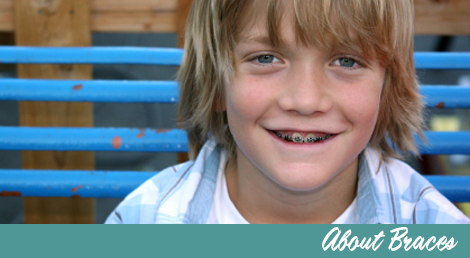Mouthguard
Not long ago mouthguards were primarily issued to those who played football. Today we understand that in every sport, from soccer to cheerleading, there is potential for damage to the teeth/mouth. This is of special concern for those who have braces. Dr. Montano believes you can never be too cautious when it comes to protecting your smile. He recommends a custom fit mouthguard for anyone participating in contact sports, or any activity that could result in damage to the teeth or mouth. Please ask one of our assistants about a mouthguard custom made for you by Dr. Montano.
For a video on mouthguards, please refer to the link below:
>> Oral Care Video
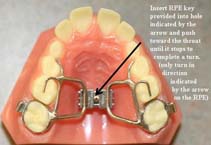 Rapid Palatal Expander (RPE)
Rapid Palatal Expander (RPE)
A palatal expander is used to widen the roof of the mouth in a patient with a narrow palate. It is a non-removable appliance bonded to the permanent molars. Using a special key, the patient and or parent is responsible for activating the RPE on a basis pre-determined by Dr. Montano. Activation requires turning the screw portion on the appliance with the key. This is usually done on a daily basis until the desired amount of turns has been achieved. Dr. Montano and his staff will instruct you on how many turns need to be made and show you step by step how to activate the expander.
The most common occurrence with the expander is opening space between the front teeth as the palate expands. This is only temporary and will be addressed once complete expansion has occurred. Occasionally, there may be pressure in the sinus area for a few days. Food can get stuck between the palate and the appliance, making brushing and rinsing after every meal necessary. During the first few days after placement, you may notice a change in speech or excessive saliva; these are normal and temporary and will lessen the more you talk. As with anything new, it takes time to get used to it. If you miss a turn, continue with only one turn per day until all turns have been completed. Never double up on turns! If the appliance ever feels loose, do not continue with any additional turns and contact the office as soon as possible.
 W-ARCH
W-ARCH
The W-arch obviously got its name from its appearance. It is another form of expansion of the upper teeth. Unlike the RPE, it does not expand the whole upper arch but instead widens only the teeth in the arch form. The W-Arch is a non-removable appliance bonded to the permanent upper molars. It has been activated prior to placement and will expand at a gradual rate, requiring no help from the patient or parents.
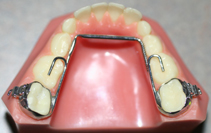 Lower Fixed Schwartz
Lower Fixed Schwartz
This appliance is bonded to the lower permanent molars and incorporates a wire with a spring that runs behind the lower front teeth. The lower fixed Schwartz is used to expand the teeth in the lower arch by consistent gradual force.
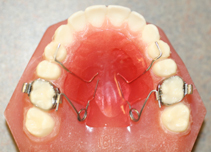 Pendulum
Pendulum
A pendulum aids in moving the upper molars back. This is needed when a patient has a large overjet (the upper teeth stick out too far). First, the molars are moved back into the desired position; then the rest of the teeth are retracted into the remaining space, virtually eliminating the overjet without extracting any teeth. The pendulum has an acrylic piece that acts as an anchor on the roof of the mouth, and a piece of wire with coil activation is attached to bands cemented on both of the permanent molars. The coils provide constant steady pressure to drive the molars back. Occasionally, food can accumulate under the acrylic piece on the palate. It is very important to brush and rinse vigorously after every meal to keep this area clean. A water pik is also a welcome aid in overall care.
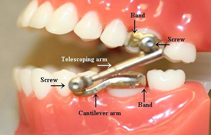 Herbst
Herbst
The Herbst is a bonded non-removable orthopedic device that is used to correct severe overjet/overbite, or deep bites. This appliance is predominantly used in adolescent patients because it requires active growth to be successful. The Herbst facilitates the growth of the lower jaw in a forward direction by positioning it forward and holding it there. It also simultaneously applies pressure to the upper jaw in a backwards direction.
Bands are bonded to the upper and lower molars on either side of the mouth and connected from top to bottom by telescoping arms. These arms are screwed to the bands by small screws with an Allen Wrench. These arms will not interfere with normal opening and closing of the mouth for talking or eating. In general, it is a good idea to cut up all of your food into small bites to aid in the chewing process for the first few days. Until your cheeks become accustomed to the appliance you may develop areas of irritation. You can use wax to smooth any uncomfortable areas, and sleeping on your back at night instead of your side may prove to be more comfortable. If tenderness in your teeth or muscles of the cheeks becomes a problem, Tylenol® or a similar pain reliever should provide relief. If the appliance ever becomes loose or a screw falls out, save any parts and call the office as soon as possible. We will provide you with an Allen wrench so that any loose screws can be tightened from the convenience of home.
Normally, the Herbst is worn for approximately 9 to 12 months to take advantage of individual growth for optimal results.
Elastics (Rubber band) Wear
One of the most popular questions asked is, “Will I have to wear rubber bands?” The short answer is, “Yes.” There are very few patients that go the entire course of treatment without having to wear elastics/rubber bands at some point. Orthodontic elastics correct improper bites. A pulling force is applied to the teeth when elastics are worn, working the dental arches against one another to create the desired outcome. There are numerous ways to wear elastics, depending on your specific bite, but it generally involves connecting the top and bottom arches. Once Dr. Montano has determined what classification of bite you have, he will prescribe the necessary type of elastics. The goal of elastic wear is to achieve a proper Class I bite, where all of the teeth occlude properly and there is not an excessive overbite or underbite. Patient compliance is very important to the success of elastics. Unless directed otherwise, elastics should be worn 24 hours a day. Take them out to eat and brush, and place new ones at least twice a day, usually in the morning and at night. If you run out of or loose your elastics, you may call the office and we can mail you a new bag. If you are ever uncertain of how to wear the elastics or have specific concerns, stop wearing the elastics and call the office for a check appointment. Wearing your elastics the wrong way can cause delays in finishing your treatment!
Separators
Separators, or "spacers", are small metal or rubber rings that are placed between the teeth approximately one week before a band is cemented. A separator creates a small space between two adjacent teeth to allow the band to slip over the tooth. Once adequate space has been made and the band is ready to be cemented in, the separator will be removed. While the separator is in place, flossing of the area or eating sticky, chewy foods should be avoided. These actions can dislodge the separator, making it impossible to place a band on the tooth. If a separator falls out more than a day or two before your appointment, please call the office to have it replaced.
For a video on separators please refer to the link below:
>> Oral Care Video
Headgear
Headgear is a removable orthopedic device generally used in adolescent patients during times of growth to treat discrepancies of growth in the upper or lower jaws. The head gear is made up of two parts: a facebow and strap. The facebow is the portion that goes into the mouth and is inserted into the tube holes on the molar bands. There are several different types of headgear: cervical, high pull, and reverse pull. Cervical and high pull headgear utilize a pushing force to hold the upper jaw back and allow for growth of the lower jaw, thus eliminating severe overbites. Reverse pull head gear applies a pulling force/protraction directing growth of the upper jaw forward to correct under bites. In order to be effective, headgear requires a minimum 10-14 hours of consistent wear. However, a good rule of thumb to follow is to wear the headgear anytime you are at home, including sitting and watching TV, after dinner, and at night while sleeping. Always make sure the headgear is being worn properly as per Dr. Montano's instructions. If headgear has been prescribed for you or your child, it should be brought to every appointment to ensure it fits and is being worn properly.
For a video on headgear please refer to the link below:
>> Oral Care Video

